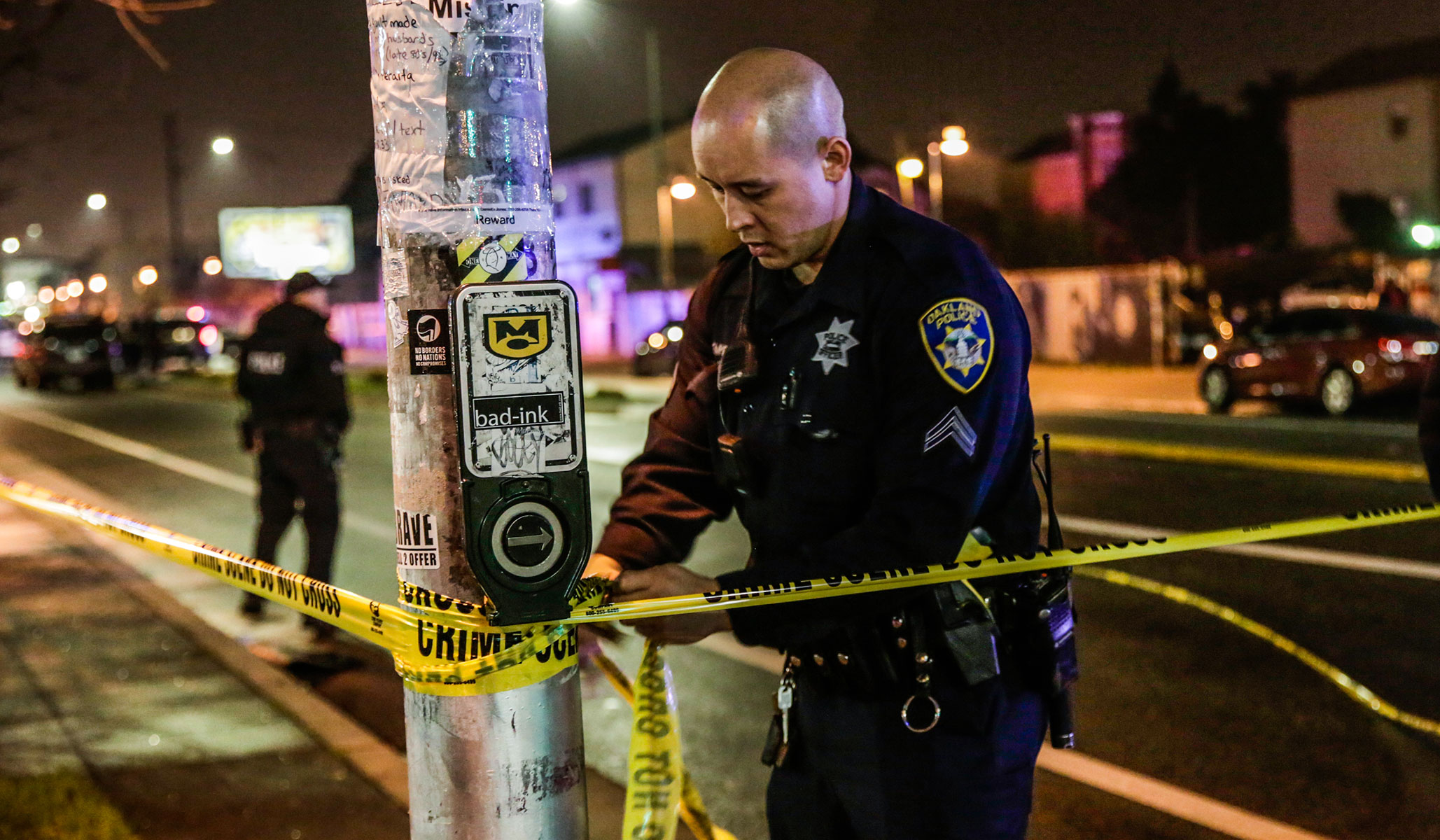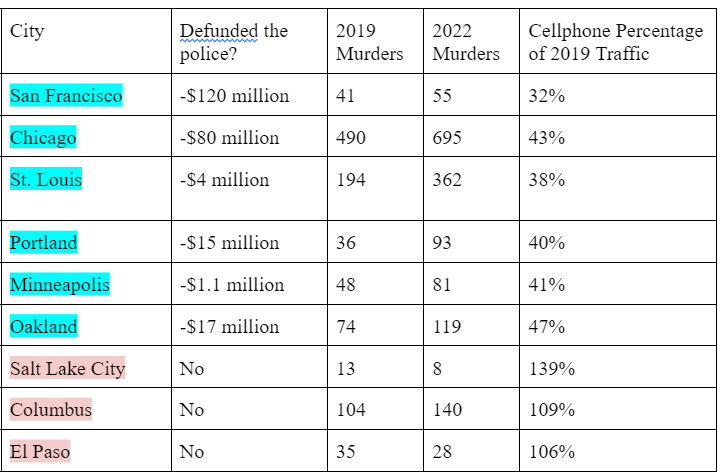


NRPLUS MEMBER ARTICLE P rogressive defunding of the police has indisputably led not just to lost lives but also to economic devastation in the cities that attempted it.
Murders increased by 39 percent nationwide, from 16,425 in 2019 to 22,900 in 2021, and remain far above pre–“defund the police” movement levels. But the cost of crime isn’t just felt in lives lost, although that is its most tragic impact. Cities that defunded the police have also been economically devastated.
Consider cellphone data, collected by the University of Toronto School of Cities, measuring downtown traffic. Cities that didn’t defund the police have generally recovered, while those that did often have a mere fraction of the traffic they had before 2020.

In July 2020, San Francisco mayor London Breed redirected $120 million from policing to fund what the San Francisco Chronicle called “a gesture of reparations for decades of city policymaking that have created or exacerbated deep inequities.” The mayor’s move led to mass resignations and retirements of police. Crime surged. According to the Hoover Institution, San Franciscans face about a 1-in-16 chance of being a victim of property crime or violent crime annually, making the city more dangerous than 98 percent of U.S. cities. “To put this in perspective,” Hoover’s Lee Ohanian writes, “Compton, California, the infamous home of drug gang turf wars, and which today remains more dangerous than 90 percent of all US cities, is almost twice as safe as San Francisco.”
University of Toronto data collected between December 2022 and February 2023 show just 32 percent as many active cellphones in downtown San Francisco as the corresponding weeks in 2019. San Francisco now faces a $728 million budget deficit and among the highest levels of office vacancy in the country. Unemployment and poverty are up. Almost half of its residents are “low income” or “very low income.” Whole Foods shuttered a flagship store because of worker-safety concerns. Mayor Breed has reversed course on defunding the police and made an emergency-funding request. In the meantime, faced with “rampant organized theft,” regularly looted retail stores are fleeing or hiring expensive private security.
In 2020, Chicago’s then-mayor Lori Lightfoot proposed a cut of $80 million from the city’s police budget. Crime surged by 41 percent. Chicago’s new mayor Brandon Johnson claimed that the shootings of 41 people over Memorial Day weekend took place because “communities have been disinvested in and traumatized,” and he demanded the city “advance a comprehensive, healing-centered approach to public safety.” Chicago had 695 homicides last year, up from 490 in 2019.
“[Crime is] seeping into every corner of our city. We have violent crime that’s happening in our restaurants,” Tyson Foods’ CEO Chris Kempczinski said last year at the Economic Club of Chicago. His company began relocating its 1,000 employees out of the city in 2022. “One of the things that I hear from our employees [is] ‘I’m not sure it’s safe to come downtown.'” Companies such as Boeing, Caterpillar, and Citadel have also recently left Chicago. Downtown traffic is at 43 percent of 2019 levels.
St. Louis cut $4 million from policing, transferring the money to social workers. Between 2019 and 2022, St. Louis lost 542 businesses downtown, including major corporate headquarters and businesses that had called the city home for decades. Poverty surged, according to the St. Louis Federal Reserve. The city has 38 percent as much downtown phone traffic as it had in 2019. St. Louis has the highest per capita crime cost in the nation, standing at $8,457 per resident as of the end of February this year, according to the St. Louis Post-Dispatch. St. Louis suffered 362 homicides last year, up from 194 in 2019.
After Portland, Ore., cut $15 million and 84 positions from its police bureau, the city’s downtown has only about 40 percent as much traffic as it had in 2019. More than 2,600 downtown Portland businesses have filed change-of-address applications with the Postal Service. Corporations such as Cracker Barrel and Walmart are fleeing the area. There were more than 63,000 instances of property theft last year. Even the state’s symphony is panicking as audience numbers plummet in the face of growing crime concerns, “threatening [performing-arts’ companies’] future in Portland.” The city is now promising a crackdown on rampant crime. Portland saw a record 93 homicides last year, more than double the city’s 36 homicides in 2019.
In Minneapolis, after the city slashed over a million dollars from policing to fund civilian “violence interrupters” and pledged to dismantle the police, carjackings increased “by more than 500%, [and] murders rose to historic levels.” Last year Minneapolis had 81 homicides, up from 48 in 2019. Downtown traffic is down to 41 percent of 2019 levels. Office-vacancy rates are spiking as the real-estate firm CBRE closed its downtown office, as did companies such as AT&T and Portico Benefit Services.
Having slashed $17 million from its policing budget, Oakland’s downtown traffic is at less than half of 2019 levels. “They’re making us go into the office and there’s shooting right in front of the building,” one Oakland office worker told the San Francisco Chronicle. “These days it feels like you could get shot anytime,” the employee continued. Oakland had 119 homicides last year, up from 74 homicides in 2019. Businesses are fleeing. Even Oakland’s mayor says that the city’s push to defund the police went “too far,” and residents are demanding that the rapidly rising level of crime be addressed.
Progressives originally attempted to blame the crime surge blighting urban areas on Covid-19 and its effects, but the data tell a different story. The surge in homicide rates began in late May 2020, after widespread riots and police-defunding, not in March when the country shut down in response to the virus.
Additionally, many cities that didn’t defund their police departments suffered through exactly the same pandemic but have since recovered. Salt Lake City, which increased police funding during this period, saw an increase of 139 percent in downtown traffic. Columbus and El Paso, which refused to defund their police departments, saw an increase of 109 percent and 106 percent in downtown traffic respectively. El Paso also saw 28 murders in 2022, a decrease from 35 in 2019.
The economic costs of this crime wave are devastating. Pre-pandemic crime already cost America an estimated $2.6 trillion annually, or 12 percent of U.S. GDP. One Justice Department experiment from 2006 estimated that each burglary costs a community $25,000, each assault $70,000, and each murder $10 million ($15.3 million when adjusted for inflation). Another study found that every murder has a social cost to the community of $30 million ($39 million today). This means that the low-end estimate of the social damage caused just by the increase of 6,475 murders between 2019 and 2021 is between $99 billion and $252.5 billion, roughly equal in value to America’s fleet of ten Nimitz-class aircraft carriers.
Cities that didn’t defund the police often saw homicide rates decline or grow only modestly. Salt Lake City’s and El Paso’s murder rates decreased by 38 percent and 20 percent respectively, while Columbus’s grew by 34 percent (from 104 to 140). Meanwhile, Chicago’s homicides jumped by 42 percent, San Francisco’s by 34 percent, St. Louis’s by 87 percent, Portland’s by 158 percent, Minneapolis’s by 69 percent, and Oakland’s by 61 percent.
American cities are paying the price of defunding the police in invaluable human lives and extreme economic damage. Republicans who have long opposed the dismantling of police departments seem intent on capitalizing on the issue in off-year elections. Jeff Landry, for example, the leading Republican candidate for governor of Louisiana, is running an ad titled “Enough is Enough with Violent Crime,” touting his credentials as a former police officer and attorney general while promising to hold progressive district attorneys and the “defund the police” movement “accountable for violent crime.” All the evidence of the past three years is on his side.
